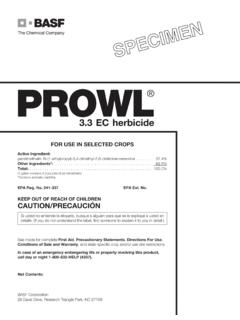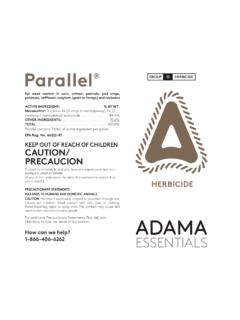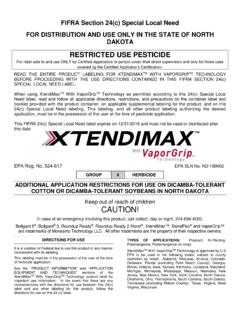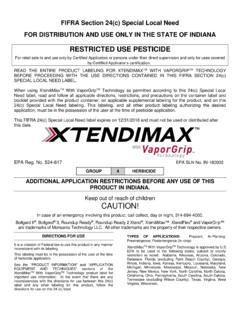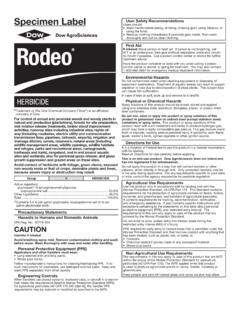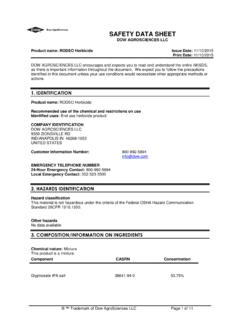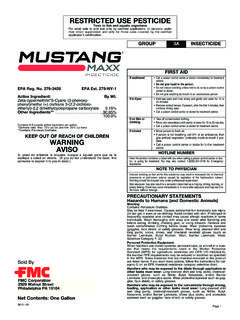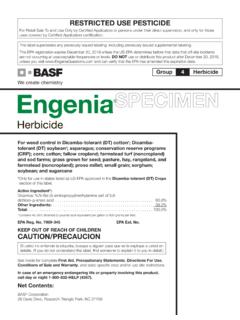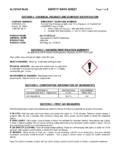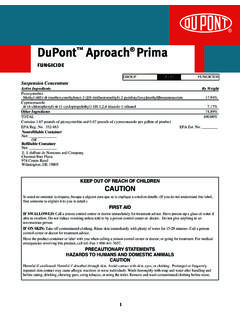Transcription of 2,4-D AMINE 4 SAFETY DATA SHEET Page of - CDMS
1 2,4-D AMINE 4 SAFETY data SHEET Page 1 of 6 SECTION 1 - CHEMICAL PRODUCT AND COMPANY IDENTIFICATION COMPANY ADDRESS: EMERGENCY TELEPHONE NUMBERS: ALBAUGH, LLC (800) 424-9300 (CHEMTREC, transportation and spills) Ankeny, IA 50021 PRODUCT NAME : 2, 4-D AMINE 4 CHEMICAL NAME : Dimethylamine Salt of 2,4-Dichlorophenoxyacetic Acid PRODUCT USE : Herbicide PRODUCT CODE : EPA Reg. No 42750-19 SECTION 2 - HAZARDS IDENTIFICATION SUMMARY (As defined by OSHA Hazard Communication Standard, 29 CFR ) Clear light amber liquid with a pungent odor. HEALTH HAZARDS: DANGER. Corrosive. Causes irreversible eye damage if not treated promptly. PHYSICAL HAZARDS: May release toxic fumes if burned. ENVIRONMENTAL HAZARDS: May be toxic to fish, aquatic invertebrates and non-target plants.
2 Use of this chemical in areas where soils are permeable, and the water table is shallow, may result in groundwater contamination. SECTION 3 - COMPOSITION, INFORMATION OF INGREDIENTS COMPONENT PERCENTAGE CAS NUMBER Dimethylamine Salt of 2,4-Dichlorophenoxyacetic Acid % 2008-39-1 Inert Ingredients N/A SECTION 4 - FIRST MEASURES First Aid responders should use protective equipment in Section 8 if there is a potential for exposure to product. IF IN EYES: Hold eye open and rinse slowly and gently with water for 15-20 minutes. Remove contact lenses, if present, after the first 5 minutes, then continue rinsing eye. Call a poison control center or doctor for treatment advice. IF SWALLOWED: Call a poison control center or doctor immediately for treatment advice. Have person sip a glass of water if able to swallow.
3 Do not induce vomiting unless told to do so by the poison control center or doctor. Do not give anything by mouth to an unconscious person. IF ON SKIN OR CLOTHING: Take off contaminated clothing. Rinse skin immediately with plenty of water for 15-20 minutes. Call a poison control center or doctor for treatment advice. IF INHALED: Move person to fresh air, if person is not breathing, call 911 or an ambulance, then give artificial respiration, preferably mouth-to-mouth if possible. Call a poison control center or doctor for further treatment advice. NOTE TO PHYSICIAN: Probable mucosal damage may contraindicate the use of gastric lavage. Have the product container or label with you when calling a poison control center or doctor, or going for treatment. You may also contact 1-800-424-9300 for emergency medical treatment.
4 2,4-D AMINE 4 SAFETY data SHEET Page 2 of 6 SECTION 5 - FIRE FIGHTING MEASURES National Fire Protection Rating (NFPA) HEALTH 3 FLAMMABILITY 1 REACTIVITY 1 4=Severe 3=Serious 2=Moderate 1=Slight 0=Minimal FLASHPOINT: >100 C EXTINGUISHING MEDIA: Water spray, Foam FIRE AND EXPLOSION HAZARD: Hydrogen chloride, Oxides of nitrogen from thermal decomposition. FIRE FIGHTING INSTRUCTIONS: Evacuate area and fight fire upwind from a safe distance to avoid possible hazardous fumes and decomposition products. Dike and collect water used to fight fire to prevent environmental damage due to run off. Foam or dry chemical fire extinguishing systems are preferred to prevent environmental damage from excessive water runoff.
5 FIRE FIGHTING EQUIPMENT: Self-contained breathing apparatus with full facepiece and protective clothing. SECTION 6 - ACCIDENTAL RELEASE MEASURES IN CASE OF SPILLS OR LEAKS: Clean up spills immediately, observing precautions in Section 8 of this document. Isolate hazard area. Keep unnecessary and unprotected personnel from entering. SMALL SPILL: Absorb small spills on sand, vermiculite or other inert absorbent. Place contaminated material in appropriate container for disposal. LARGE SPILL: Dike large spills using absorbent or impervious material such as clay or sand. Recover and contain as much free liquid as possible for reuse. Allow absorbed material to solidify, and scrape up for disposal. Do not allow wash waters from clean up to enter waterways. SECTION 7 - HANDLING AND STORAGE KEEP OUT OF REACH OF CHILDREN!
6 HANDLING: Use only in a well-ventilated area. Do not reuse this container. Wear proper SAFETY equipment specified in Section 8 when mixing, loading or otherwise handling concentrate. STORAGE: Do not store this product near fertilizers, seeds, insecticides, or fungicides. Reclose all partially used containers by thoroughly tightening screw cap. Absorb any spill with a suitable clay absorbent and dispose of as indicated under "Pesticide Disposal. Protect from freezing. If stored below freezing, the product must be warmed to at least 70 F and agitated before using. This does not affect the efficiency of the product. Refer to product label for additional and complete storage guidance. 2,4-D AMINE 4 SAFETY data SHEET Page 3 of 6 SECTION 8 - EXPOSURE CONTROLS, PERSONAL PROTECTION EXPOSURE LIMITS (8 hour TWA, ppm): COMPONENT OSHA TWA ACIGH TWA Dimethylamine Salt of 2,4-dichlorophenoxyacetic Acid 10 10 ENGINEERING CONTROLS: Proper ventilation is required when handling or using this product to keep exposure to airborne contaminants below the exposure limit.
7 Local mechanical exhaust ventilation may be required. Facilities storing or utilizing this material should be equipped with an eyewash facility and a SAFETY shower. PERSONAL PROTECTIVE EQUIPMENT: Some materials that are chemical-resistant to this product are butyl rubber, natural rubber, neoprene or nitrile rubber. If you want more options, follow the instructions for Category A on an EPA chemical-resistance category selection chart . All mixers, loaders, applicators, flaggers, and other handlers must wear: 1. Long-sleeved shirt and long pants. 2. Shoes and socks. 3. Chemical resistant gloves when applying with any handheld nozzle or equipment, mixing or loading, cleaning up spills or equipment, or otherwise exposed to the concentrate. 4. Chemical resistant apron when, mixing or loading, cleaning up spills or equipment, or otherwise exposed to the concentrate.
8 5. Wear protective eyewear (goggles or face shield). Discard clothing and other absorbent materials that have been drenched or heavily contaminated with this product s concentrate. Do not reuse them. Follow manufacturer s instructions for cleaning/maintaining PPE. If no such instructions for washables exist, use detergent and hot water. Keep and wash PPE separately from other laundry. After each day of use, clothing or PPE must not be reused until it has been cleaned. USER SAFETY RECOMMENDATIONS: Wash hands before eating, drinking, chewing gum, using tobacco or using the toilet. Remove clothing immediately if pesticide gets inside. Then wash thoroughly and put on clean clothing. Remove PPE immediately after handling this product. Wash outside of gloves before removing.
9 As soon as possible wash thoroughly and change into clean clothing. SECTION 9 - PHYSICAL AND CHEMICAL PROPERTIES Appearance: Clear light amber liquid Odor: Pungent odor pH: - Melting Point: Not applicable Boiling Point: No data Flash Point: 100 C Evaporation Rate: No data Flammability: Not flammable Flammability Limits: Not applicable Vapor Pressure: mm Hg at 20C Vapor Density: < 1 (water vapor) Density: g/ml ( lb/gal.)* Solubility: Soluble Partition Coefficient: log Pow - < @ 25 C (glyphosate) Auto-Ignition Temperature: No data Decomposition Temperature: No data Viscosity: cSt @ 20 C, cSt @40 C *Listed density is an approximate value and does not necessarily represent that of a specific batch. 2,4-D AMINE 4 SAFETY data SHEET Page 4 of 6 SECTION 10 - STABILITY AND REACTIVITY PRODUCT REACTIVITY: Non-reactive CHEMICAL STABILITY: Stable under normal conditions HAZARDOUS POLYMERIZATION: Will not occur CONDITIONS TO AVOID: Avoid excessive heat.
10 INCOMPATIBLE MATERIALS: Oxidizing agents and acids HAZARDOUS DECOMPOSITION PRODUCTS: Thermal decomposition may release toxic gases such as HCl SECTION 11 - TOXICOLOGICAL INFORMATION ACUTE TOXICITY: Oral LD50 (rat) - > 1,000 mg/Kg Dermal LD50 (rat) - > 5,000 mg/Kg Inhalation LC50 (rat) - > mg/L Eye Irritation (rabbit) - Severe Skin Irritation (rabbit) - Moderate Sensitization (guinea pig) - Contact sensitizer CARCINOGEN STATUS: OSHA - No NTP - No IARC - 2B TERATOGENICITY: Laboratory tests have shown decreased fetal body weights at doses toxic to mother animals MUTAGENICITY: Weight of evidence indicates that 2,4-D acid is not mutagenic SECTION 12 - ECOLOGICAL INFORMATION ENVIRONMENTAL SUMMARY: This pesticide may be toxic to fish and aquatic invertebrates. For terrestrial uses: Do not apply directly to water, or to areas where surface water is present, or to intertidal areas below the mean high water mark.
